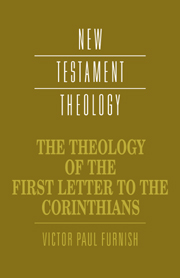Book contents
- Frontmatter
- Contents
- Editor's preface
- Preface
- List of abbreviations
- 1 Introduction
- 2 Knowing God, belonging to Christ
- 3 Belonging to Christ in an unbelieving society
- 4 Belonging to Christ in a believing community
- 5 Hoping in God, the “all in all”
- 6 The significance of 1 Corinthians for Christian thought
- Select bibliography
- Index of references
- Index of names
- Index of subjects
6 - The significance of 1 Corinthians for Christian thought
Published online by Cambridge University Press: 05 June 2012
- Frontmatter
- Contents
- Editor's preface
- Preface
- List of abbreviations
- 1 Introduction
- 2 Knowing God, belonging to Christ
- 3 Belonging to Christ in an unbelieving society
- 4 Belonging to Christ in a believing community
- 5 Hoping in God, the “all in all”
- 6 The significance of 1 Corinthians for Christian thought
- Select bibliography
- Index of references
- Index of names
- Index of subjects
Summary
It is customary to describe 1 and 2 Corinthians, Galatians, and Romans as the four “main” Pauline letters. In part, this description reflects the fact that they are longer than the other three letters generally accepted as authentic, but primarily it reflects the widespread judgment that Paul's theology is most fully and carefully presented in Galatians and Romans, while his apostolic self-understanding and views on practical, moral issues are most readily discerned in 1 and 2 Corinthians. However, these common judgments need to be modified in several respects.
First, no one or two Pauline letters can be absolutely definitive either of the apostle's thought or of his ministry. Each letter provides no more than a snapshot of what he was thinking and doing within one particular period of time and one specific set of circumstances. Second, the other three letters of unquestionably Pauline authorship – 1 Thessalonians, Philippians, and Philemon – are surely no less important for being shorter. All three contribute substantially to our understanding of Paul's message and mission.
Third, it is precisely by considering all of the letters together, within their various situational contexts, that one is able to get some measure of how the individual snapshots can contribute to a larger panoramic view of the apostle's understanding and preaching of the gospel. Whether it is possible to document any significant change or development in his theology and pastoral strategies remains a matter of spirited debate among interpreters; but one must allow at least for the possibility that over time there was some change in these.
- Type
- Chapter
- Information
- The Theology of the First Letter to the Corinthians , pp. 122 - 144Publisher: Cambridge University PressPrint publication year: 1999



